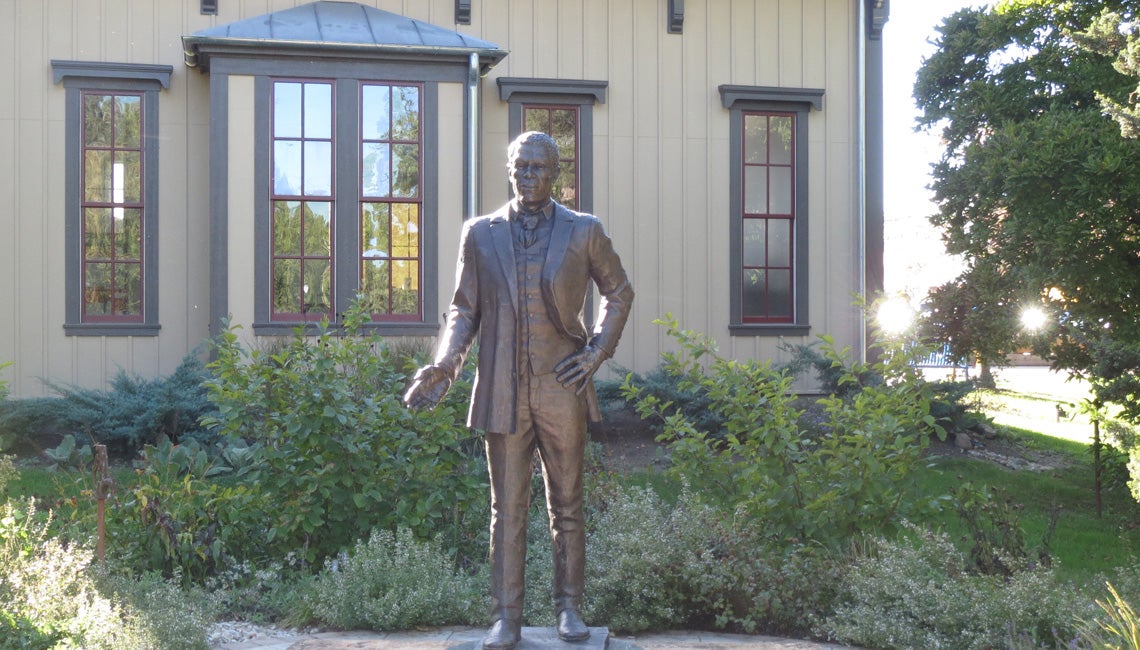During the first holiday season after the death of her husband, the noted local artist Jack Hubbard, in 1987, Pat Hubbard received a curious gift delivered to her Yellow Springs home: two sacks — one filled with flour, the other with sugar. The following year brought that same remarkable gift, and more followed every holiday season until her own death in 1999.
Providing flour and sugar to the widows (and widowers) of the town is a Yuletide tradition unique to Yellow Springs, and it dates back 130 years — all of it thanks to the generosity of a formerly enslaved man named Wheeling Gaunt, who settled in the southwest Ohio village after he purchased his own freedom during the Civil War.
A life-sized bronze statue of Wheeling Gaunt, designed by the renowned sculptor and longtime village resident Brian Maughan, stands at the busy intersection of Dayton Street and Xenia Avenue (U.S. 68) in downtown Yellow Springs. It graces a small park on the Little Miami Scenic Trail, and engraved on its pedestal is a quote attributed to him: “It’s not what we have but what we share.”
“Wheeling Gaunt was a person of faith and a very resilient man who did not let adversity beat him down; he used it as a motivation to achieve,” says Brenda Hubbard Ibarra, Jack and Pat’s daughter. Although she had been born and raised in Yellow Springs, Ibarra was unaware of Gaunt’s story until her mother started getting those gifts. Inspired, she immersed herself in researching that history, and in 2021, she self-published Legacy of Grace: Musings on the Life and Times of Wheeling Gaunt.
“My mother had been so impressed, so grateful, that someone could be so full of kindness and generosity despite such bitter hardships,” Ibarra says.
Gaunt was born in 1812 on a tobacco plantation in Carrollton, Kentucky, son of the white plantation master and an unidentified Black woman whom his father seems to have sold when Wheeling was only about 4 years old.
Because his father permitted him to work away from the plantation, Gaunt earned money of his own by selling apples, polishing boots, and doing other odd jobs, and saved enough by the mid-1840s to buy his freedom from his white half-brothers for $900.
As a free man, Gaunt worked as a teamster and laborer in Carrollton, and within a few years, he was able to pay for the manumission of his wife, Amanda, and for another young relative. He also began building a substantial commercial and residential real estate portfolio.
During that time, Yellow Springs, about 100 miles to the northeast, had a growing anti-slavery and egalitarian reputation — home to Antioch College, whose first president, Horace Mann, was a staunch abolitionist, and close to Wilberforce, where the African Methodist Episcopal Church was operating a fledgling college, now Wilberforce University, for Black students.
Gaunt prospered in Yellow Springs. He worked hard to acquire prime properties, and built a handsome home for himself and Amanda (who died in 1885), as well as other homes that are still in use today. He also learned to read and write, and even ran, albeit unsuccessfully, for the village school board.
By the time he died of kidney disease in May of 1894, Gaunt was one of Yellow Springs’ wealthiest, most highly respected residents. The Yellow Springs newspaper reported that Gaunt’s memorial service was “filled to suffocation” with mourners, and his obituary in the Xenia Gazette declared, “He was one of the best citizens of our village and will leave a record and example of fair dealing and benevolence which would be well to imitate by those who are left behind.”
Gaunt willed all his Yellow Springs real estate to Wilberforce University, with the exception of 9 acres of farmland reserved for the Village of Yellow Springs — with the stipulation that income from renting it would go into a fund used to give flour to “poor worthy widows” on the evening before Christmas Day. That December, village workers delivered 69 sacks of flour to 23 widows.
Today, the acreage Gaunt donated is the Gaunt Park recreation complex, and the village continues to support the widow’s fund from swimming pool entry fees. Decades ago, the village opted to distribute sugar as well as flour to widows, and during the 2012 Christmas season, it began supplying widowers too. On average, about 90 individuals annually benefit from Gaunt’s bequest, and this year, the village dispensed 5 pounds of sugar and 5 pounds of flour to each of them during Thanksgiving week.
It’s impossible to gauge the comfort and joy that Gaunt’s simple gifts have brought to generations of villagers.
If nothing else, they are annual lessons in compassion taught nowhere else but Yellow Springs.
Legacy of Grace: Musings on the Life and Times of Wheeling Gaunt is available through the Yellow Springs 365 Project or on Amazon.










